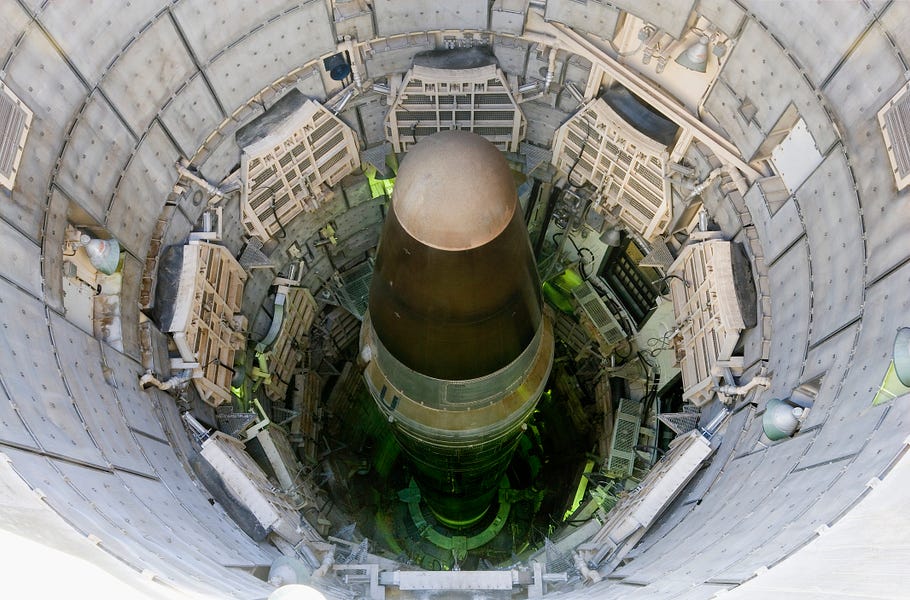It’s been a difficult few months for the so-called arms control community. Cherished myths and deeply held beliefs have been dashed by Russian, Chinese, and North Korean behavior. Reciprocity has been demonstrated to be an empty concept. And yet the alluring illusions persist. It’s time to sweep the hoary old folktales away and confront the new realities.
First, the idea that U.S. restraint in nuclear armaments and modernization will produce similar policies and actions by the three presidents for life who rule our nuclear adversaries should be discarded. We should have recognized this when we imposed a “modernization holiday” on our strategic forces beginning in the Bush 43 administration; rather than demonstrating any in reciprocating U.S. restraint, Russia, China, and, yes, even, North Korea proceeded apace to build and deploy new nuclear forces. We should have recognized that while we were scrupulously abiding by no fewer than nine “post-Cold War” arms control treaties and executive agreements, Russia was busily violating each one while still claiming to be abiding by their provisions. And, most recently, when the Biden administration first postponed and then canceled a test of a Minuteman III ICBM, Putin’s response was a test of Russia’s new mammoth Sarmat heavy ICBM, capable of carrying 10 independently targeted warheads—the diplomatic equivalent of giving the West a middle finger.
Second, the Pentagon, the Defense Department of the United States, went out of its way to characterize the Sarmat test as “not a threat to the United States or its allies.” Perhaps that was true by an extremely narrow, literal reading. But the test was intended as a clear reminder and warning to the West by Putin of Russia’s nuclear capabilities in the context of Russian anger at NATO’s increased and ongoing material support to Ukraine (a point made absolutely clear by Russian media coverage in which the weapon was described as the “killer of Americans” and graphic images of flight times to European capitals were on display). But, most fundamentally, the Sarmat is intended to be a threat to the U.S. nuclear deterrent; it is a dinosaur-like throwback to the heavily MIRVed ICBMs that the USSR deployed in the 1970s and that were created explicitly to destroy our Minuteman force and threaten the most responsive element of the U.S. nuclear deterrent. (MIRV stands for multiple independent reentry vehicle—each ICBM can carry multiple warheads that can strike different targets.)
Even some of those who might have understood the menace behind the test felt compelled to argue that the Sarmat test demonstrated the value of arms control because the Russians notified us in advance of the test launch in accordance with New START provisions. Arms control is supposed to bound and limit threats. Test notifications are a third- or fourth-level ancillary benefit, not at all central to the purpose of arms control.
The events of the last several months have also exposed the fact that the administration’s policy of “reducing the role of nuclear weapons”—which it has used to justify the cancellation of the Submarine Launched Nuclear Cruise missile (SLCM-N)—has been a complete failure. Putin has indulged in the most blatant forms of attempted nuclear blackmail since the end of the Cold War. Kim Jong-un’s rhetoric, missile tests, and missile parades are cut from the same cloth. And Beijing continues to deploy new ICBMs at a rapid rate. If anything, the role of nuclear weapons has increased—it’s just that we seem unable to recognize it.
Recognizing the realities of our current nuclear predicament leads in a different direction. The current trajectory of increasing threats of nuclear escalation by U.S. adversaries calls not for more arms control but more deliberate thinking about nuclear deterrence and the imperative of modernizing the aging U.S. nuclear arsenal. We have written in the past about the qualitative dimension, but the dramatic events of the past year—China’s nuclear buildup and Russia’s efforts to paralyze U.S. decision-making on Ukraine with bombastic nuclear threats—confront the U.S. with a totally unprecedented situation: strategic competition with two near peer nuclear powers. In the past, stable deterrence required the ability to withstand a nuclear first strike and still retain enough capability to inflict unacceptable damage on an adversary with an assured second-strike retaliatory capability. During the Cold War the U.S. was able to satisfy itself that it could measure “how much is enough” to maintain a stable equilibrium. Today, as STRATCOM Commander Adm. Charles Richards recently noted, “The war in Ukraine and China’s nuclear trajectory—their strategic breakout—demonstrates that we have a deterrence and assurance gap based on the threat of limited nuclear employment.”
As things stand today, it is not at all clear that within a few years the U.S. will retain enough to deter two well-armed nuclear competitors. Despite years of efforts at ensuring “strategic stability,” U.S. may need to rethink its approach. De-MIRVing U.S. ICBMs (as we did in the 1990s) because some said they were inherently destabilizing has had no effect on Russian and Chinese nuclear modernization programs. In the short run, the U.S. may need to procure more AGM 181 Long-Range Standoff (LRSO) cruise missiles and upload U.S. bombers to take advantage of the bomber counting rule under the New START Treaty to increase the arsenal for enhanced deterrence.
With New START set to expire in 2026, the U.S. may want to upload its Minuteman III missiles back up to three warheads each to rapidly increase its warhead count. As the ground-based strategic deterrent program/Sentinal ICBM moves forward, U.S. policymakers will have to wrestle with the question of whether it should have a single or multiple warheads. For the longer term, an increase in the Columbia-class ballistic missile submarine buy may also be necessary. Ironically, these steps may do more to promote the prospects of agreements to limit arms in the future than simply reciting the hardy perennial bromides of the arms control community.
Eric S. Edelman and Franklin Miller have held senior positions in national security affairs over administrations of both parties.




Please note that we at The Dispatch hold ourselves, our work, and our commenters to a higher standard than other places on the internet. We welcome comments that foster genuine debate or discussion—including comments critical of us or our work—but responses that include ad hominem attacks on fellow Dispatch members or are intended to stoke fear and anger may be moderated.
With your membership, you only have the ability to comment on The Morning Dispatch articles. Consider upgrading to join the conversation everywhere.